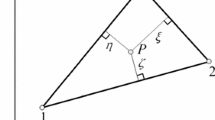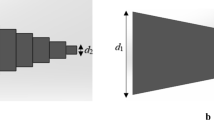Abstract
In this investigation, a systematic procedure that can be used for modeling joint constraints for the absolute nodal coordinate formulation is developed. To this end, the non-generalized intermediate coordinates are introduced to derive a mapping between the generalized gradient coordinates and the non-generalized rotation parameters. With this mapping, a wide variety of joint constraints can be defined for the absolute nodal coordinate formulation in terms of the non-generalized reference coordinates and, therefore, existing well-developed constraint libraries formulated for the rigid body reference coordinates can be directly employed without significant modifications in existing codes. Furthermore, in order to define a rigid surface at the joint definition point, a set of orthonormality conditions is imposed on the gradient coordinates. This leads to not only accurate modeling of interface to mechanical joint, but also a simpler definition of the joint coordinate system obtained by the orthonormal gradient vectors. For this reason, a simpler form of constraint Jacobian and quadratic velocity vectors can be obtained as compared to those of the existing approach which requires the use of highly nonlinear joint coordinate system. A systematic procedure for eliminating the non-generalized coordinates and the dependent Lagrange multipliers associated with the coordinate mapping equations from the equations of motion is presented. As a result, a standard augmented form of the equations of motion can be obtained in terms of the generalized coordinates only. Several numerical examples are presented in order to demonstrate the use of the joint constraint formulation developed in this investigation.
Similar content being viewed by others
References
Shabana, A.A.: Dynamics of Multibody Systems. Cambridge University Press, New York (2005)
Nikravesh, P.E.: Computer-Aided Analysis of Mechanical Systems. Prentice-Hall, Englewood Cliffs (1998)
Bae, B.S., Han, J.M., Choi, J.H.: An implementation method for constrained flexible multibody dynamics using a virtual body and joint. Multibody Syst. Dyn. 4, 297–315 (2000)
Shabana, A.A., Yakoub, R.Y.: Three-dimensional absolute nodal coordinate formulation for beam elements: theory. ASME J. Mech. Des. 123, 606–613 (2001)
Sugiyama, H., Escalona, J.L., Shabana, A.A.: Formulation of three-dimensional joint constraints using the absolute nodal coordinates. Nonlinear Dyn. 31, 167–195 (2003)
Hussein, B.A., Weed, D., Shabana, A.A.: Clamped end conditions and cross section deformation in the finite element absolute nodal coordinate formulation. Nonlinear Dyn. 21, 375–393 (2009)
Sugiyama, H., Gerstmayr, J., Shabana, A.A.: Deformation modes in the finite element absolute nodal coordinate formulation. J. Sound Vib. 298, 1129–1149 (2006)
Schwab, A.L., Meijaard, J.P.: Comparison of three-dimensional flexible beam elements for dynamic analysis: classical finite element formulation and absolute nodal coordinate formulation. ASME J. Comput. Nonlinear Dyn. 5, 011010 (2010)
Sugiyama, H., Suda, Y.: A curved beam element in the analysis of flexible multibody systems using the absolute nodal coordinates. IMechE J. Multi-Body Dyn. 221, 219–231 (2007)
Simo, J.C., Vu-Quoc, L.: Three-dimensional finite-strain rod model, part II: computational aspects. Comput. Methods Appl. Mech. Eng. 58, 79–116 (1986)
Bonet, J., Wood, R.D.: Nonlinear Continuum Mechanics for Finite Element Analysis. Cambridge University Press, New York (1997)
Shabana, A.A., Zaazaa, K.E., Sugiyama, H.: Railroad Vehicle Dynamics: Computational Approach. CRC Press, Boca Raton (2007)
Yakoub, R.Y., Shabana, A.A.: Use of Cholesky coordinates and the absolute nodal coordinate formulation in the computer simulation of flexible multibody systems. Nonlinear Dyn. 20, 267–282 (1999)
Author information
Authors and Affiliations
Corresponding author
Rights and permissions
About this article
Cite this article
Sugiyama, H., Yamashita, H. Spatial joint constraints for the absolute nodal coordinate formulation using the non-generalized intermediate coordinates. Multibody Syst Dyn 26, 15–36 (2011). https://doi.org/10.1007/s11044-010-9236-5
Received:
Accepted:
Published:
Issue Date:
DOI: https://doi.org/10.1007/s11044-010-9236-5




